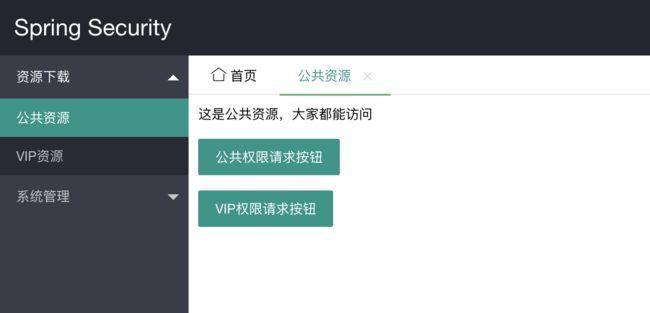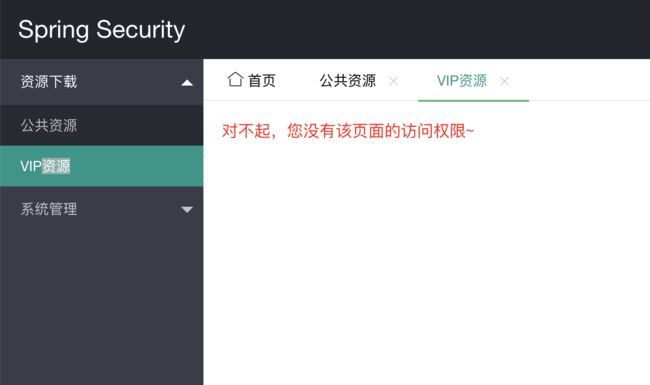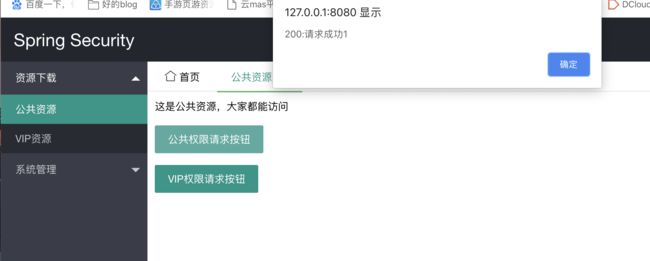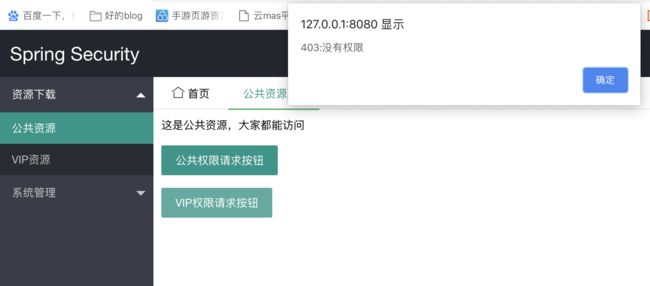Spring Boot 2.X(十八):集成 Spring Security-登录认证和权限控制
前言
在企业项目开发中,对系统的安全和权限控制往往是必需的,常见的安全框架有 Spring Security、Apache Shiro 等。本文主要简单介绍一下 Spring Security,再通过 Spring Boot 集成开一个简单的示例。
Spring Security
什么是 Spring Security?
Spring Security 是一种基于 Spring AOP 和 Servlet 过滤器 Filter 的安全框架,它提供了全面的安全解决方案,提供在 Web 请求和方法调用级别的用户鉴权和权限控制。
Web 应用的安全性通常包括两方面:用户认证(Authentication)和用户授权(Authorization)。
用户认证指的是验证某个用户是否为系统合法用户,也就是说用户能否访问该系统。用户认证一般要求用户提供用户名和密码,系统通过校验用户名和密码来完成认证。
用户授权指的是验证某个用户是否有权限执行某个操作。
2.原理
Spring Security 功能的实现主要是靠一系列的过滤器链相互配合来完成的。以下是项目启动时打印的默认安全过滤器链(集成5.2.0):
[
org.springframework.security.web.context.request.async.WebAsyncManagerIntegrationFilter@5054e546,
org.springframework.security.web.context.SecurityContextPersistenceFilter@7b0c69a6,
org.springframework.security.web.header.HeaderWriterFilter@4fefa770,
org.springframework.security.web.csrf.CsrfFilter@6346aba8,
org.springframework.security.web.authentication.logout.LogoutFilter@677ac054,
org.springframework.security.web.authentication.UsernamePasswordAuthenticationFilter@51430781,
org.springframework.security.web.savedrequest.RequestCacheAwareFilter@4203d678,
org.springframework.security.web.servletapi.SecurityContextHolderAwareRequestFilter@625e20e6,
org.springframework.security.web.authentication.AnonymousAuthenticationFilter@19628fc2,
org.springframework.security.web.session.SessionManagementFilter@471f8a70,
org.springframework.security.web.access.ExceptionTranslationFilter@3e1eb569,
org.springframework.security.web.access.intercept.FilterSecurityInterceptor@3089ab62
]
- WebAsyncManagerIntegrationFilter
- SecurityContextPersistenceFilter
- HeaderWriterFilter
- CsrfFilter
- LogoutFilter
- UsernamePasswordAuthenticationFilter
- RequestCacheAwareFilter
- SecurityContextHolderAwareRequestFilter
- AnonymousAuthenticationFilter
- SessionManagementFilter
- ExceptionTranslationFilter
- FilterSecurityInterceptor
详细解读可以参考:https://blog.csdn.net/dushiwodecuo/article/details/78913113
3.核心组件
SecurityContextHolder
用于存储应用程序安全上下文(Spring Context)的详细信息,如当前操作的用户对象信息、认证状态、角色权限信息等。默认情况下,SecurityContextHolder 会使用 ThreadLocal 来存储这些信息,意味着安全上下文始终可用于同一执行线程中的方法。
获取有关当前用户的信息
因为身份信息与线程是绑定的,所以可以在程序的任何地方使用静态方法获取用户信息。例如获取当前经过身份验证的用户的名称,代码如下:
Object principal = SecurityContextHolder.getContext().getAuthentication().getPrincipal();
if (principal instanceof UserDetails) {
String username = ((UserDetails)principal).getUsername();
} else {
String username = principal.toString();
}
其中,getAuthentication() 返回认证信息,getPrincipal() 返回身份信息,UserDetails 是对用户信息的封装类。
Authentication
认证信息接口,集成了 Principal 类。该接口中方法如下:
| 接口方法 | 功能说明 |
|---|---|
| getAuthorities() | 获取权限信息列表,默认是 GrantedAuthority 接口的一些实现类,通常是代表权限信息的一系列字符串 |
| getCredentials() | 获取用户提交的密码凭证,用户输入的密码字符窜,在认证过后通常会被移除,用于保障安全 |
| getDetails() | 获取用户详细信息,用于记录 ip、sessionid、证书序列号等值 |
| getPrincipal() | 获取用户身份信息,大部分情况下返回的是 UserDetails 接口的实现类,是框架中最常用的接口之一 |
AuthenticationManager
认证管理器,负责验证。认证成功后,AuthenticationManager 返回一个填充了用户认证信息(包括权限信息、身份信息、详细信息等,但密码通常会被移除)的 Authentication 实例。然后再将 Authentication 设置到 SecurityContextHolder 容器中。
AuthenticationManager 接口是认证相关的核心接口,也是发起认证的入口。但它一般不直接认证,其常用实现类 ProviderManager 内部会维护一个 List 列表,存放里多种认证方式,默认情况下,只需要通过一个 AuthenticationProvider 的认证,就可被认为是登录成功。
UserDetailsService
负责从特定的地方加载用户信息,通常是通过JdbcDaoImpl从数据库加载实现,也可以通过内存映射InMemoryDaoImpl实现。
UserDetails
该接口代表了最详细的用户信息。该接口中方法如下:
| 接口方法 | 功能说明 |
|---|---|
| getAuthorities() | 获取授予用户的权限 |
| getPassword() | 获取用户正确的密码,这个密码在验证时会和 Authentication 中的 getCredentials() 做比对 |
| getUsername() | 获取用于验证的用户名 |
| isAccountNonExpired() | 指示用户的帐户是否已过期,无法验证过期的用户 |
| isAccountNonLocked() | 指示用户的账号是否被锁定,无法验证被锁定的用户 |
| isCredentialsNonExpired() | 指示用户的凭据(密码)是否已过期,无法验证凭证过期的用户 |
| isEnabled() | 指示用户是否被启用,无法验证被禁用的用户 |
Spring Security 实战
1.系统设计
本文主要使用 Spring Security 来实现系统页面的权限控制和安全认证,本示例不做详细的数据增删改查,sql 可以在完整代码里下载,主要是基于数据库对页面 和 ajax 请求做权限控制。
1.1 技术栈
- 编程语言:Java
- 编程框架:Spring、Spring MVC、Spring Boot
- ORM 框架:MyBatis
- 视图模板引擎:Thymeleaf
- 安全框架:Spring Security(5.2.0)
- 数据库:MySQL
- 前端:Layui、JQuery
1.2 功能设计
- 实现登录、退出
- 实现菜单 url 跳转的权限控制
- 实现按钮 ajax 请求的权限控制
- 防止跨站请求伪造(CSRF)攻击
1.3 数据库层设计
t_user 用户表
| 字段 | 类型 | 长度 | 是否为空 | 说明 |
|---|---|---|---|---|
| id | int | 8 | 否 | 主键,自增长 |
| username | varchar | 20 | 否 | 用户名 |
| password | varchar | 255 | 否 | 密码 |
t_role 角色表
| 字段 | 类型 | 长度 | 是否为空 | 说明 |
|---|---|---|---|---|
| id | int | 8 | 否 | 主键,自增长 |
| role_name | varchar | 20 | 否 | 角色名称 |
t_menu 菜单表
| 字段 | 类型 | 长度 | 是否为空 | 说明 |
|---|---|---|---|---|
| id | int | 8 | 否 | 主键,自增长 |
| menu_name | varchar | 20 | 否 | 菜单名称 |
| menu_url | varchar | 50 | 是 | 菜单url(Controller 请求路径) |
t_user_roles 用户权限表
| 字段 | 类型 | 长度 | 是否为空 | 说明 |
|---|---|---|---|---|
| id | int | 8 | 否 | 主键,自增长 |
| user_id | int | 8 | 否 | 用户表id |
| role_id | int | 8 | 否 | 角色表id |
t_role_menus 权限菜单表
| 字段 | 类型 | 长度 | 是否为空 | 说明 |
|---|---|---|---|---|
| id | int | 8 | 否 | 主键,自增长 |
| role_id | int | 8 | 否 | 角色表id |
| menu_id | int | 8 | 否 | 菜单表id |
实体类这里不详细列了。
2.代码实现
2.0 相关依赖
org.springframework.boot
spring-boot-starter-web
org.springframework.boot
spring-boot-starter-test
test
org.junit.vintage
junit-vintage-engine
org.springframework.boot
spring-boot-starter-jdbc
org.springframework.boot
spring-boot-devtools
true
mysql
mysql-connector-java
runtime
org.mybatis.spring.boot
mybatis-spring-boot-starter
2.1.0
org.springframework.boot
spring-boot-starter-thymeleaf
com.alibaba
fastjson
1.2.47
org.springframework.boot
spring-boot-starter-security
2.1 继承 WebSecurityConfigurerAdapter 自定义 Spring Security 配置
/**
prePostEnabled :决定Spring Security的前注解是否可用 [@PreAuthorize,@PostAuthorize,..]
secureEnabled : 决定是否Spring Security的保障注解 [@Secured] 是否可用
jsr250Enabled :决定 JSR-250 annotations 注解[@RolesAllowed..] 是否可用.
*/
@Configurable
@EnableWebSecurity
//开启 Spring Security 方法级安全注解 @EnableGlobalMethodSecurity
@EnableGlobalMethodSecurity(prePostEnabled = true,securedEnabled = true,jsr250Enabled = true)
public class WebSecurityConfig extends WebSecurityConfigurerAdapter{
@Autowired
private CustomAccessDeniedHandler customAccessDeniedHandler;
@Autowired
private UserDetailsService userDetailsService;
/**
* 静态资源设置
*/
@Override
public void configure(WebSecurity webSecurity) {
//不拦截静态资源,所有用户均可访问的资源
webSecurity.ignoring().antMatchers(
"/",
"/css/**",
"/js/**",
"/images/**",
"/layui/**"
);
}
/**
* http请求设置
*/
@Override
public void configure(HttpSecurity http) throws Exception {
//http.csrf().disable(); //注释就是使用 csrf 功能
http.headers().frameOptions().disable();//解决 in a frame because it set 'X-Frame-Options' to 'DENY' 问题
//http.anonymous().disable();
http.authorizeRequests()
.antMatchers("/login/**","/initUserData")//不拦截登录相关方法
.permitAll()
//.antMatchers("/user").hasRole("ADMIN") // user接口只有ADMIN角色的可以访问
// .anyRequest()
// .authenticated()// 任何尚未匹配的URL只需要验证用户即可访问
.anyRequest()
.access("@rbacPermission.hasPermission(request, authentication)")//根据账号权限访问
.and()
.formLogin()
.loginPage("/")
.loginPage("/login") //登录请求页
.loginProcessingUrl("/login") //登录POST请求路径
.usernameParameter("username") //登录用户名参数
.passwordParameter("password") //登录密码参数
.defaultSuccessUrl("/main") //默认登录成功页面
.and()
.exceptionHandling()
.accessDeniedHandler(customAccessDeniedHandler) //无权限处理器
.and()
.logout()
.logoutSuccessUrl("/login?logout"); //退出登录成功URL
}
/**
* 自定义获取用户信息接口
*/
@Override
public void configure(AuthenticationManagerBuilder auth) throws Exception {
auth.userDetailsService(userDetailsService).passwordEncoder(passwordEncoder());
}
/**
* 密码加密算法
* @return
*/
@Bean
public BCryptPasswordEncoder passwordEncoder() {
return new BCryptPasswordEncoder();
}
}
2.2 自定义实现 UserDetails 接口,扩展属性
public class UserEntity implements UserDetails {
/**
*
*/
private static final long serialVersionUID = -9005214545793249372L;
private Long id;// 用户id
private String username;// 用户名
private String password;// 密码
private List userRoles;// 用户权限集合
private List 2.3 自定义实现 UserDetailsService 接口
/**
* 获取用户相关信息
* @author charlie
*
*/
@Service
public class UserDetailServiceImpl implements UserDetailsService {
private Logger log = LoggerFactory.getLogger(UserDetailServiceImpl.class);
@Autowired
private UserDao userDao;
@Autowired
private RoleDao roleDao;
@Autowired
private MenuDao menuDao;
@Override
public UserEntity loadUserByUsername(String username) throws UsernameNotFoundException {
// 根据用户名查找用户
UserEntity user = userDao.getUserByUsername(username);
System.out.println(user);
if (user != null) {
System.out.println("UserDetailsService");
//根据用户id获取用户角色
List roles = roleDao.getUserRoleByUserId(user.getId());
// 填充权限
Collection authorities = new HashSet();
for (Role role : roles) {
authorities.add(new SimpleGrantedAuthority(role.getRoleName()));
}
//填充权限菜单
List menus=menuDao.getRoleMenuByRoles(roles);
return new UserEntity(username,user.getPassword(),authorities,menus);
} else {
System.out.println(username +" not found");
throw new UsernameNotFoundException(username +" not found");
}
}
}
2.4 自定义实现 URL 权限控制
/**
* RBAC数据模型控制权限
* @author charlie
*
*/
@Component("rbacPermission")
public class RbacPermission{
private AntPathMatcher antPathMatcher = new AntPathMatcher();
public boolean hasPermission(HttpServletRequest request, Authentication authentication) {
Object principal = authentication.getPrincipal();
boolean hasPermission = false;
if (principal instanceof UserEntity) {
// 读取用户所拥有的权限菜单
List menus = ((UserEntity) principal).getRoleMenus();
System.out.println(menus.size());
for (Menu menu : menus) {
if (antPathMatcher.match(menu.getMenuUrl(), request.getRequestURI())) {
hasPermission = true;
break;
}
}
}
return hasPermission;
}
}
2.5 实现 AccessDeniedHandler
自定义处理无权请求
/**
* 处理无权请求
* @author charlie
*
*/
@Component
public class CustomAccessDeniedHandler implements AccessDeniedHandler {
private Logger log = LoggerFactory.getLogger(CustomAccessDeniedHandler.class);
@Override
public void handle(HttpServletRequest request, HttpServletResponse response,
AccessDeniedException accessDeniedException) throws IOException, ServletException {
boolean isAjax = ControllerTools.isAjaxRequest(request);
System.out.println("CustomAccessDeniedHandler handle");
if (!response.isCommitted()) {
if (isAjax) {
String msg = accessDeniedException.getMessage();
log.info("accessDeniedException.message:" + msg);
String accessDenyMsg = "{\"code\":\"403\",\"msg\":\"没有权限\"}";
ControllerTools.print(response, accessDenyMsg);
} else {
request.setAttribute(WebAttributes.ACCESS_DENIED_403, accessDeniedException);
response.setStatus(HttpStatus.FORBIDDEN.value());
RequestDispatcher dispatcher = request.getRequestDispatcher("/403");
dispatcher.forward(request, response);
}
}
}
public static class ControllerTools {
public static boolean isAjaxRequest(HttpServletRequest request) {
return "XMLHttpRequest".equals(request.getHeader("X-Requested-With"));
}
public static void print(HttpServletResponse response, String msg) throws IOException {
response.setCharacterEncoding("UTF-8");
response.setContentType("application/json; charset=utf-8");
PrintWriter writer = response.getWriter();
writer.write(msg);
writer.flush();
writer.close();
}
}
}
2.6 相关 Controller
登录/退出跳转
/**
* 登录/退出跳转
* @author charlie
*
*/
@Controller
public class LoginController {
@GetMapping("/login")
public ModelAndView login(@RequestParam(value = "error", required = false) String error,
@RequestParam(value = "logout", required = false) String logout) {
ModelAndView mav = new ModelAndView();
if (error != null) {
mav.addObject("error", "用户名或者密码不正确");
}
if (logout != null) {
mav.addObject("msg", "退出成功");
}
mav.setViewName("login");
return mav;
}
}
登录成功跳转
@Controller
public class MainController {
@GetMapping("/main")
public ModelAndView toMainPage() {
//获取登录的用户名
Object principal= SecurityContextHolder.getContext().getAuthentication().getPrincipal();
String username=null;
if(principal instanceof UserDetails) {
username=((UserDetails)principal).getUsername();
}else {
username=principal.toString();
}
ModelAndView mav = new ModelAndView();
mav.setViewName("main");
mav.addObject("username", username);
return mav;
}
}
用于不同权限页面访问测试
/**
* 用于不同权限页面访问测试
* @author charlie
*
*/
@Controller
public class ResourceController {
@GetMapping("/publicResource")
public String toPublicResource() {
return "resource/public";
}
@GetMapping("/vipResource")
public String toVipResource() {
return "resource/vip";
}
}
用于不同权限ajax请求测试
/**
* 用于不同权限ajax请求测试
* @author charlie
*
*/
@RestController
@RequestMapping("/test")
public class HttptestController {
@PostMapping("/public")
public JSONObject doPublicHandler(Long id) {
JSONObject json = new JSONObject();
json.put("code", 200);
json.put("msg", "请求成功" + id);
return json;
}
@PostMapping("/vip")
public JSONObject doVipHandler(Long id) {
JSONObject json = new JSONObject();
json.put("code", 200);
json.put("msg", "请求成功" + id);
return json;
}
}
2.7 相关 html 页面
登录页面
防止跨站请求伪造(CSRF)攻击
退出系统
退出系统
ajax 请求页面
2.8 测试
测试提供两个账号:user 和 admin (密码与账号一样)
由于 admin 作为管理员权限,设置了全部的访问权限,这里只展示 user 的测试结果。




完整代码
github
码云
非特殊说明,本文版权归 朝雾轻寒 所有,转载请注明出处.
原文标题:Spring Boot 2.X(十八):集成 Spring Security-登录认证和权限控制
原文地址: https://www.zwqh.top/article/info/27
如果文章有不足的地方,欢迎提点,后续会完善。
如果文章对您有帮助,请给我点个赞,请扫码关注下我的公众号,文章持续更新中…
![]()